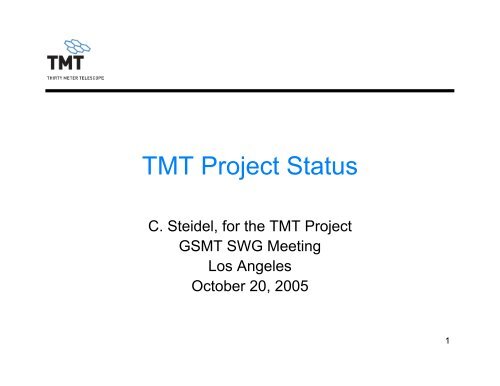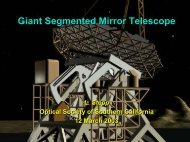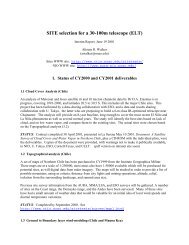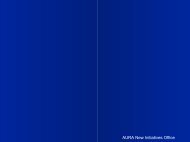TMT Project Status - GSMT Program Office
TMT Project Status - GSMT Program Office
TMT Project Status - GSMT Program Office
Create successful ePaper yourself
Turn your PDF publications into a flip-book with our unique Google optimized e-Paper software.
<strong>TMT</strong> <strong>Project</strong> <strong>Status</strong><br />
C. Steidel, for the <strong>TMT</strong> <strong>Project</strong><br />
<strong>GSMT</strong> SWG Meeting<br />
Los Angeles<br />
October 20, 2005<br />
1
Contents<br />
Current Design Baseline<br />
Instruments and adaptive optics systems<br />
Capabilities and their connection to the <strong>GSMT</strong>-SWG<br />
report<br />
Operations models and US community access<br />
Schedule<br />
2
The <strong>TMT</strong> Partnership<br />
<strong>TMT</strong> follows the NAS Decadal Survey recommendation<br />
that a public-private partnership is the best way to build &<br />
operate a US-led 30-m telescope<br />
Current partners (for Design and Development Phase)<br />
are:<br />
– University of California<br />
– Caltech<br />
– ACURA (Canada)<br />
– AURA (NSF)<br />
Although partners are currently “equal”, ultimate shares<br />
(e.g. of observing time) will be based on contributions to<br />
capital & operations.<br />
3
<strong>TMT</strong> Precursor Studies<br />
<strong>TMT</strong> follows from a careful consideration of three,<br />
independently-conceived & independently-reviewed,<br />
point designs representing ≈$6M total effort<br />
CELT (UC+Caltech)<br />
VLOT (Canada)<br />
<strong>GSMT</strong> (NOAO/Gemini)<br />
– Broad exploration of technical options<br />
– Positive reviews by outside reviewers<br />
– <strong>TMT</strong> consolidates the best aspects of these designs<br />
– Single reference design now established by the <strong>Project</strong><br />
4
<strong>TMT</strong> Overall Structure<br />
<strong>TMT</strong> governance established in June 2003<br />
– Agreements between the partners<br />
– Formation of Science Advisory Committee<br />
equal membership/representation from each of the 4 partners<br />
– Formation of Board of Directors<br />
– Appointment of <strong>Project</strong> Manager, Gary Sanders (Apr 2004)<br />
Development Phases<br />
– Design Development Phase (2004-2008)<br />
$35M secured from G&B Moore Foundation (Caltech/UC)<br />
$17.5M from each of Canada and AURA (NSF)<br />
– Construction phase (2009 – 2014)<br />
– Science Operations (2015 - )<br />
(Assuming timely delivery of capital & operational resources)<br />
5
Distributed <strong>Project</strong> Effort<br />
<strong>TMT</strong> <strong>Project</strong> Headquarters- Pasadena : 32 FTE<br />
ACURA/AURA/UC/Caltech : ~35 FTE<br />
Instrument teams, industry design teams: additional ~50<br />
participants<br />
– major industry design teams include: AMEC, SAGEM, ITT, Zygo,<br />
Cilas, tOSC, Hytec, Night Sky<br />
6
The <strong>Project</strong> Ahead, First Light and the<br />
First Decade of <strong>TMT</strong> Science<br />
The <strong>TMT</strong> Science Advisory Committee (SAC) has<br />
provided a Science Requirements Document (SRD)<br />
– It presents a vision of the first decade of <strong>TMT</strong><br />
– Most of the effort will be to realize the foundation for this decade,<br />
reaching first light era science<br />
Design and Development Phase (DDP) – (2004 – 2008)<br />
Construction Phase – (2009 – 2014)<br />
Early Operations Phase – (2012 – 2016)<br />
Operations Phase – (2016 – 2024)<br />
7
The <strong>Project</strong>, The Science, The Systems<br />
Design Development Phase (DDP) budget and schedule defined<br />
<strong>Project</strong> office established in Pasadena<br />
<strong>Project</strong> organization in place for DDP<br />
– Partnership teams<br />
– Instrument partners<br />
– Industrial partners<br />
Science Requirements Document (SRD) delivered and guiding DDP<br />
Detailed Science Case under continuing development (currently a<br />
90-page document)<br />
Science Advisory Committee (SAC) in intimate dialog with project<br />
DDP activities<br />
Systems studies mounting<br />
Systems engineering processes developing<br />
Operational scenarios discussion is started<br />
8
<strong>TMT</strong> Reference Design<br />
30m filled aperture, highly segmented<br />
Aplanatic Gregorian (AG) two mirror<br />
telescope<br />
f/1 primary<br />
f/15 final focus<br />
Field of view 20 arcmin<br />
Elevation axis in front of the primary<br />
Wavelength coverage 0.31 – 28 µm<br />
Operational zenith angle range 1° thru 65°<br />
Instruments (and their associated AO<br />
systems) are located on large Nasmyth<br />
platforms, addressed by an articulated<br />
tertiary mirror.<br />
Both seeing-limited and adaptive optics<br />
observing modes<br />
AO system requirements and architecture<br />
defined<br />
First generation instrument requirements<br />
defined<br />
9
30m Primary Mirror Concept<br />
738 × 1.2m segments<br />
each 0.040m thick<br />
10
<strong>TMT</strong> Reference Design<br />
11
M2 System Overview<br />
M2 system<br />
Two interchangeable assemblies:<br />
CM2 & AM2<br />
CM2 - “Conventional” M2<br />
• Seeing limited performance<br />
• Used for commissioning<br />
• Initial operations<br />
• Will be replaced by AM2<br />
• Kept as maintenance spare<br />
AM2 - Adaptive M2<br />
• Full AO capability<br />
• Developed under separate<br />
study (SAGEM)<br />
12
M3 System Overview<br />
M3 system<br />
Mirror<br />
M3 cell<br />
• 4.11 x 2.91m flat to cover<br />
20 arcmin fov<br />
• Meniscus glass or glass<br />
ceramic substrate<br />
• High stability<br />
active/passive supports<br />
Positioner<br />
• Rotates to switch beam to<br />
Nasmyth instruments<br />
• Active tracking to steer<br />
beam onto instrument<br />
13
SRD Science Instruments<br />
Adaptive Optic systems defined<br />
– NFIRAOS (Narrow Field facility AO system) for first light<br />
– MOAO (“Multi-Object Adaptive Optics” ~20 positionable, 5”<br />
compensated patches in 5’ adressable field)<br />
– MIRAO (MidIR AO)<br />
– MCAO (wide field AO, optimized for photometric and astrometric goals)<br />
Eight Instruments identified<br />
– IRIS, a NIR imager and integral field spectrograph working at the<br />
diffraction limit, 0.8-2.5 microns; fed by NFIRAOS<br />
– WFOS, a wide field, seeing-limited optical spectrograph (possibly<br />
GLAO-compensated)<br />
– IRMOS, a NIR multi-object integral field spectrograph fed by MOAO<br />
– MIRES, a mid-IR high resolution echelle spectrograph fed by MIRAO<br />
– PFI, a “planet formation instrument”, which combines a high contrast<br />
AO system and an imaging spectrograph.<br />
– NIRES, a NIR echelle spectrograph, also fed by NFIRAOS<br />
– HROS, a high spectral resolution optical echelle spectrograph<br />
– WIRC, a wide field NIR camera fed by multi-conjugate AO<br />
14
IRIS<br />
Infrared Imaging Spectrograph<br />
Integral Field Spectrograph and Imager working at the diffraction limit<br />
Wavelength range: 0.8-2.5µm; goal 0.6-5µm<br />
Field of view: < 2 arcsec for IFU, up to 10” for imaging mode<br />
Spatial sampling: 0.004 arcsec per pixel (Nyquist sampled (λ/2D)) over 4096 pixels for<br />
IFU); over 10x10 arcsec for imaging<br />
– Plate scale adjustable 0.004, 0.009, 0.022, 0.050 arcsec/pixel<br />
– 128x128 spatial pixels with small (Dλ/λ ≤ 0.05) wavelength coverage<br />
Spectral resolution<br />
– R=4000 over entire Y,J, H, K,( L) bands, one band at a time<br />
– R=2-50 for imaging mode<br />
Low background (increase inter-OH sky + tel by no more than 15%)<br />
Detector: Dark current and read noise ≤ 5% of background for t=2000s<br />
Throughput: as high as practical<br />
Parallel imaging: goal<br />
15
WFOS<br />
Wide Field Optical Spectrograph<br />
– Multi-object spectroscopy over as much of 20’ field as possible<br />
– Wavelength range: 0.31-1.1µm (0.31-1.6µm goal). ADC required<br />
– Field of view: 75 arcmin 2 ; goal: 300 arcmin 2<br />
– Total slit length ≥ 500 arcsec<br />
– Image quality: ≤ 0.2 arcsec FWHM over any 0.1µm<br />
– Spatial sampling: ≤0.15 arcsec per pixel, goal ≤ 0.10 arcsec<br />
– Spectral resolution: R=5-5000 for 0.75” slit; goal: 150-6000<br />
– Throughput: ≥ 30%<br />
– Sensitivity: photon noise limited for all exposures > 60s<br />
– Background subtraction systematics must be negligible compared to photon<br />
noise for total exposure times as long as 100 Ks<br />
– Stability: Flexure < 0.1 pixel at the detector is required<br />
– Desired: cross dispersed mode, IFU option, narrow band imaging, enhanced<br />
image quality using adaptive optics (GLA0)<br />
GLA0 trade study completed<br />
16
IRMOS<br />
Infrared Multi-Object Spectrograph<br />
MOAO/Deployable IFU spectrometer<br />
0.8-2.5µm<br />
FoV: IFU heads deployable over 5 arcmin field<br />
Wavefront quality: preserve that delivered by AO system<br />
Image quality: diffraction-limited images, tip-tilt ≤0.015 arcsec rms<br />
Spatial sampling<br />
– 0.05x0.05 arcsec pixels, IFU head 2.0 arcsec, ≥ 10 IF units<br />
Spectral resolution<br />
– R=2000-10000 over entire J, H, K bands, one band at a time<br />
– R=2-50 for imaging mode<br />
Low background (increase inter-OH sky + tel by no more than 15%)<br />
Detector<br />
– Dark current and read noise ≤ 5% of background for t=2000s<br />
Throughput: as high as practical<br />
17
MIRES<br />
Mid-IR Echelle Spectrometer<br />
Mid-IR Diffraction Limited Spectrometer<br />
8-18µm, 5-28µm goal<br />
FoV 10 arcsec<br />
Slit length: 3 arcsec order separation, or IFU<br />
Wavefront quality: preserve that delivered by AO system<br />
Image quality: diffraction-limited images, limited by AO<br />
Spatial sampling<br />
– 0.017x0.017 arcsec pixels<br />
Spectral resolution<br />
– 5000< R
1-2.5µm, goal 1-5µm<br />
PFI<br />
Planet Formation Imager<br />
Field of view 0.03-1 arcsec radius<br />
Image quality/contrast<br />
– Detect planet at 10 6 contrast or 10 7 goal for 1st generation<br />
system<br />
– Suitable coronagraph<br />
– Optical system should not preclude 10 8 contrast in H band for<br />
R
NIRES<br />
Near IR Echelle Spectrometer<br />
Wavelength range: 1-5µm, simultaneous 1-2.4µm, 3.5-5µm<br />
Field of view of acquisition camera: 10 arcsec, 0.0035 arcsec/pixel<br />
Slit length: 2 arcsec<br />
Image quality: diffraction limited<br />
Spatial sampling: Nyquist sampled (λ/2D)<br />
Spectral resolution: 20,000
HROS<br />
High Resolution Optical Spectrometer<br />
Seeing limited optical spectrometer<br />
Wavelength range: 0.31-1µm (0.3-1.3µm goal)<br />
Field of view: 10 arcsec<br />
Total slit length 5 arcsec, separation between orders<br />
Image quality: ≤ 0.15 arcsec rms<br />
Spatial sampling: ≤ 0.2 arcsec per pixel<br />
Spectral resolution: R=50,000 for 1 arcsec slit,<br />
R=90,000 with slicer<br />
Throughput: ≥ 30% telescope focal plane to detected<br />
photons<br />
21
WIRC<br />
Wide-field Infrared Camera<br />
Precision photometry and astrometry instrument<br />
Wavelength range: 0.8-5µm, goal 0.6-5µm<br />
Field of view: 30 arcsec, contiguous<br />
Image quality: diffraction limited as delivered by AO<br />
Spatial sampling: Nyquist sampled (λ/2D)<br />
Spectral resolution: R=5-100 with filters<br />
22
AO Systems<br />
<strong>TMT</strong> is designed for high-performance (120nm wavefront error) AO<br />
from the beginning<br />
Adaptive Optic systems defined in SRD<br />
– NFIRAOS (Narrow Field facility AO system) for first light<br />
2’ “technical field”, upgrades to wide field system.<br />
– MOAO (“Multi-Object Adaptive Optics” ~20 positionable, 5′′<br />
compensated patches in 5′ technical field)<br />
– MIRAO (MidIR AO, optimized for low emissivity in mid-IR)<br />
– MCAO (wide field AO, optimized for photometric and astrometric goals)<br />
Significant effort during DDP to define AO systems, component risks<br />
and global image quality error budget for telescope-AO-instrument<br />
systems.<br />
23
First Light AO Capabilities<br />
NFIRAOS (Narrow-Field IR AO System)<br />
– Facility AO system for IRIS (and eventually NIRES and WIRC)<br />
– 150-200 nm RMS WFE as initially implemented<br />
– 50% sky coverage at the galactic pole<br />
– 30 arc sec compensated FOV<br />
– cooled optical system to minimize background in K band<br />
– Implied component and design parameters:<br />
Order 60x60 wavefront sensing and correction<br />
5-9 LGS WFS (with ~17W of laser power per beacon)<br />
MCAO system with 2 DMs conjugate to 0 and 10-12 km<br />
Near IR NGS tip/tilt/focus sensing with 2’ diameter guide field<br />
MIRAO (option)<br />
– 7-20 µm (goal 3-20 µm) spectral band, 10” field of view<br />
– 1 (3) LGS, 1 tip/tilt/focus near IR NGS WFS<br />
– Order 15x15 (30x30) DM (requires 3 additional warm surfaces)<br />
24
Instrument Deployment Concept<br />
25
Instrument Design Feasibility Studies<br />
•9 instrument feasibility<br />
studies funded via open<br />
competition<br />
- Feb 2006 completion<br />
- Feedback to telescope, AO and<br />
operations requirements<br />
- Develop instrument concepts<br />
- Extended Science Case via<br />
associated science teams -- wide<br />
community participation<br />
•major presence at upcoming<br />
SPIE expected from all of these<br />
studies<br />
(U. Colorado HROS concept)<br />
26
<strong>TMT</strong> AO Development <strong>Program</strong><br />
DDP program addresses <strong>TMT</strong> AO architecture, design<br />
and technology development<br />
Key technologies and demonstrations<br />
– MEMS<br />
– Lasers<br />
– Infrared tip-tilt wavefront sensing<br />
– Open loop control<br />
– Tomography<br />
– Wavefront sensor<br />
– Adaptive secondary technology<br />
27
<strong>TMT</strong> Experience with Adaptive Optics<br />
UC Lick<br />
CFHT<br />
Palomar<br />
Gemini<br />
Keck<br />
28
Adaptive Optics has come of age!<br />
Ghez (UCLA) & collaborators<br />
Gemini Hokupa’a/QUIRC image of<br />
Galactic Center. Expanded view<br />
shows IRS 13E & W in K p<br />
40 x 40 arcsecond mosaic, colorcomposite<br />
NIRC2 image (at ~2.2 um)<br />
of the Galactic Center using Keck Laser<br />
29
Keck AO Imaging of Uranus<br />
Courtesy: L. Sromovsky<br />
30
NFIRAOS side view<br />
Science<br />
Laser<br />
Natural<br />
31
Optical Design of LGS<br />
WFS<br />
SH WFS<br />
6 Copies<br />
Wavefront Error<br />
1.4x spec<br />
Zoom<br />
DM/WFS<br />
Distortion<br />
3x spec<br />
(Map scale<br />
100x)<br />
32
Subsystem<br />
Decomposition<br />
33
<strong>GSMT</strong> SWG Science Case<br />
The goals/capabilities of <strong>TMT</strong> are very well aligned with<br />
those of the <strong>GSMT</strong> SWG<br />
1<br />
First light and the early<br />
assembly of galaxies<br />
The discovery and<br />
characterization of extrasolar<br />
planets<br />
Stellar Populations in the<br />
Local Universe: formation<br />
and evolution of galaxies<br />
Tomographic surveys at z>2<br />
IRIS, IRMOS, WFOS<br />
PFI, HROS, NIRES, IRIS<br />
IRIS, HROS, WIRC<br />
WFOS<br />
1<br />
<strong>GSMT</strong> high-level goals from “Frontier Science Enabled by a <strong>GSMT</strong>” SWG report 7.2.03<br />
34
<strong>TMT</strong> Instrument Summary<br />
Instrument<br />
Near-IR DL Spectrometer &<br />
Imager (IRIS)<br />
Spectral<br />
Resolution<br />
≤4000<br />
Example Science Cases<br />
• Assembly of galaxies at large redshift<br />
• Black holes/AGN/Galactic Center<br />
• Resolved stellar populations in crowded fields<br />
Wide-field Optical<br />
Spectrometer (WFOS)<br />
300 - 5000<br />
• IGM structure and composition 25.5
Site Testing<br />
An effort of the <strong>TMT</strong> <strong>Project</strong> Site team, CTIO, NIO,<br />
UNAM, UofH, Gemini, CFHT, HIA<br />
Robotic data collection underway at 2 sites in Chile<br />
(Tolar, Armazones), San Pedro Martir (Mexico), and<br />
Mauna Kea; two more Chilean sites in process.<br />
– high altitude sites (>4000m) in both hemispheres included<br />
The most comprehensive (and ambitious) astronomical<br />
site survey work ever<br />
Site Requirements Document has been authored and is<br />
under review<br />
– Includes data evaluation/figure of merit strategy<br />
36
Site Testing: Instruments & Parameters<br />
Weather stations<br />
DIMM – seeing monitors<br />
MASS – turbulence profilers<br />
SODAR – acoustic sounders<br />
IRMA – mid-infrared radiometers<br />
ASCA – Allsky cameras<br />
Particle sensors<br />
Sonic anemometers<br />
Simulations, satellite analysis<br />
– temp, hum, wind, press, sol.rad, heat flux<br />
– seeing, coh. time, basic photometry<br />
– high-el. profiles, isopl. angle, coh. time<br />
– 20 – 800m turb/wind profiles, coh.time<br />
– PWV, atm. transparency<br />
– Cloud statistics (incl. cirrus), light pollution<br />
– Ground level dust particle count<br />
– 7m wind, temperature, turbulence<br />
– Turbulence, weather, long baseline<br />
Other considerations:<br />
– Location, elevation, geology, access, cost of construction and operation,<br />
operation model, ...<br />
37
DDP Instrumentation Plan<br />
38
Construction phase<br />
39
Telescope Optics <strong>Status</strong><br />
An effort of <strong>TMT</strong> <strong>Project</strong>, UCSC, UCI, NIO, industrial<br />
partners SAGEM, Zygo, ITT/Tinsley, Hytec<br />
Telescope requirements and error budget development is<br />
supporting optics design efforts<br />
M1 segment polishing awards initiated (Zygo, SAGEM,<br />
ITT/Tinsley)<br />
– Segments must be produced at lowest possible cost<br />
M1 Segment Assembly design underway with Hytec Inc. of<br />
Los Alamos<br />
M2 (secondary), M3 (tertiary) designs well underway<br />
40
Telescope Structure <strong>Status</strong><br />
An effort of <strong>TMT</strong> <strong>Project</strong> <strong>Office</strong>, HIA and AMEC<br />
Reference Design studied and dissected by AMEC<br />
– Design strengths, weaknesses studied and points of departure<br />
for next design phase are identified<br />
Methods and infrastructure for assessing structure<br />
performance (finite element analysis (FEA), merit<br />
function routines (MFR)) are being implemented<br />
Work on requirements and interfaces accelerating<br />
41
Telescope Controls <strong>Status</strong><br />
Actuator and edge sensor studies underway<br />
– Studies of humidity sensitivity of Keck edge sensors by <strong>TMT</strong><br />
underway at Keck<br />
– Edge sensor design study underway with LBL group that worked<br />
on Keck design<br />
Alignment and Phasing System design underway with<br />
UCI group that designed Keck system<br />
42
AO/Science Instruments <strong>Status</strong><br />
All feasibility studies underway for WFOS, IRIS, MIRES, PFI,<br />
HROS, IRMOS<br />
NFIRAOS design well underway by <strong>TMT</strong> <strong>Project</strong> and HIA<br />
group<br />
SAGEM adaptive secondary contract underway<br />
CILAS piezo deformable mirror contract underway<br />
Laser Guidestar Facility design underway with NOAO group<br />
Laser development following Gemini/Keck program<br />
Real Time Controller design study with tOSC<br />
UVic woofer/tweeter experiment underway<br />
Palomar Multiple Guidestar experiment underway<br />
AOWG/IWG and weekly design coordination meetings are<br />
quite effective<br />
43
Enclosure <strong>Status</strong><br />
An effort of HIA, AMEC, NIO, <strong>TMT</strong> <strong>Project</strong> <strong>Office</strong><br />
Successful 6 month design review conducted July 8<br />
Enclosure Requirements Document under version<br />
control<br />
Design effort had been comparing 4 configurations<br />
– Downselect to 2 on July 8<br />
– Downselect to 1 at 9 month review<br />
In fact, July 8 review resulted in tentative downselect to<br />
one configuration<br />
– Calotte selected due to lower mass, lower cost, though<br />
technically novel<br />
– Carousel carried for 3 months as conventional backup<br />
44
Enclosure Structural Optimization<br />
<br />
Aperture ring<br />
at Zenith=0 deg<br />
<br />
<br />
<br />
Aperture ring<br />
at Zenith=65<br />
deg<br />
45
Summit/Support Facilities <strong>Status</strong><br />
Facilities requirements review August 9, 2005<br />
Facilities Requirements and site dependence discussed<br />
extensively at Aspen (Sep 2005) “<strong>TMT</strong> Week” meeting<br />
– The arrangement of summit and support facilities is strongly<br />
dependent on sites<br />
Goal is to transition to Architect/Engineer studies this<br />
year<br />
Operations strategy impacts requirements<br />
– Site Selection requirements document provides initial discussion<br />
– Observatory Scientist David Silva will lead study of this area<br />
46
Operations & Development<br />
Operations and development<br />
– Assume $40M/yr for operations<br />
– Assume $20M/yr for development<br />
Possible sources of operational funds ($40M/yr)<br />
– UC+Caltech 25%, Canada 25%, NSF 50%<br />
Operations style<br />
– We will support traditional astronomer-led observing<br />
– We will support queue or service observing<br />
– Mix will be set by maximizing scientific productivity<br />
– Data will be archived and available to all after proprietary period<br />
Purpose of Development funds<br />
– New instruments<br />
– Instrument upgrades<br />
– AO upgrades and new AO capabilities<br />
– Facility upgrades including guiders, etc<br />
47
Observing Time<br />
If we use current projected partner contributions, we<br />
might expect observing time to be distributed very<br />
roughly as:<br />
– Private 25-50%<br />
– US Community through AURA 50-25%<br />
– Canada 25%<br />
Actual distribution will depend on financial contributions<br />
of the partners.<br />
48
Operations Planning<br />
Lead role taken by Observatory Scientist<br />
– David Silva (ESO/VLT) is joining <strong>TMT</strong> to assume this role<br />
<strong>Project</strong> Scientist and SAC will play a major role<br />
Operations Advisory Group will be formed as soon as<br />
the Observatory Scientist is on board<br />
– Group will represent the 4 partners and the operational expertise<br />
of Keck, Gemini and VLT<br />
Already can see operational questions arising in all<br />
design discussions<br />
49
Key Dates in the DDP<br />
<strong>TMT</strong> Week (Sept 26 – 30, 2005; Aspen Center for<br />
Physics)<br />
– Mid-point review of all subsystems<br />
Conceptual Design Review (CoDR) (May 8 – 11, 2006)<br />
Cost Review (Sept 25 – 29, 2006)<br />
– Update CoDR all subsystems<br />
– Cost review for project scope decisions by <strong>TMT</strong> Board<br />
PDR/Construction Proposal Review (Sept 24 – 28, 2007)<br />
– Update CoDR to PDR for critical systems<br />
– Definitive cost/scope, reference schedule<br />
50
Construction Phase<br />
Approval to start ($$ available) Jan 2008<br />
Primary mirror detail design review Apr 2008<br />
Site Development FDR Apr 2008<br />
Complete enclosure Feb 2012<br />
Complete telescope installation Oct 2012<br />
Begin segment installation Aug 2012<br />
First light with 1/4 segments Jul 2013<br />
All segments installed, phased Apr 2014<br />
Begin <strong>TMT</strong> science Jan 2015<br />
51
Major Construction Phase Milestones<br />
Construction initiated Q1CY2009<br />
Site Specific Designs/Site Mobilization Q4CY2008<br />
Site facilities/enclosure accepted – Q2CY2012<br />
Initial instrument installed – Q1CY2014<br />
Additional First Light Instruments delivered – CY2014<br />
First Light, all segments phased – Q2CY2014<br />
First science, initial instrument – Q1CY2015<br />
52
A Vision of <strong>TMT</strong> – AAS Calendar 2006<br />
53
200 Inch and <strong>TMT</strong><br />
54
END<br />
55







